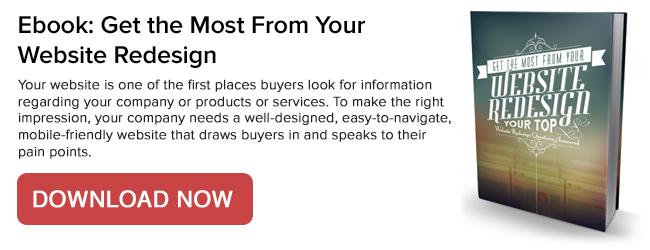.jpg) Data. Good marketers have already utilized it for email segmentation and automation. Providing that relevant, data-backed communication to users is what keeps open and click rates up and helps convert more leads to sales. But what about your website?
Data. Good marketers have already utilized it for email segmentation and automation. Providing that relevant, data-backed communication to users is what keeps open and click rates up and helps convert more leads to sales. But what about your website?
Today, three-quarters of internet users say they get frustrated when website content has nothing to do with their interests. And who wouldn’t be? When users share their information with you, the quid pro quo isn’t just the ebook they downloaded; it’s making sure all future offers are as relevant to that user as possible. If someone downloads an ebook, they should never see that offer again.
That’s a simple starting point for personalization through smart content: What you get is no longer what you see. However, a user that converts on your website should have his entire contact profile connected with his web experience. This can mean using anything from renewal dates to lead score to make each visit to your website as meaningful as possible.
So how can you take your database information and use it to make each visit to your website worth the click? Here are five ideas you can implement with some common database information:
1) Local Rep Intros
Even after all the work a buyer does in researching your organization, she still might not know who she needs to talk to in order to move the process forward. With smart content, you can put that person front and center when you make your final pitch to contact sales.
What fields do I need?
If you’re connected to a CRM, you can simply use that contact’s owner to provide the most relevant personal contact. If you have regional or local reps based on geolocation, you can set up smart content modules based on a contact’s state or even city.
Where should I use it?
The most likely place to put a brief intro to the sales rep would be on the final landing page for talking to sales.
2) Final Step Reminders
If you’re not selling through a sales team, but rather using an online portal, your pitch to website users might look a little different. You get them into the system with a free sign-up... but then the user doesn’t take another step. While you may already have email automation set up to handle this situation, a good reminder using smart content can give that user a final push just when he needs it most.
What fields do I need?
A connection with your online ordering system is a must, that way you can know each step from sign-up to purchase. The good news is, most CRM connections can provide this data. And in-house systems can generally be updated with a connection to your marking software during regular maintenance.
Where should I use it?
Remind your buyer the first moment she revisits your website. That means the homepage hero area is the perfect spot for a nice, friendly reminder.
3) Vertical Messaging
Even if you have vertical web pages, chances are the majority of your website is filled with general copy on how your solution can be used for general buyers. It may be solution-based information, but it’s not a solution for a buyer’s specific industry. With smart content, you can change that generic messaging to meet the more focused needs of buyers in different verticals.
What fields do I need?
Vertical messaging can be performed based on a user’s previous download of a vertical targeted ebook or whitepaper. But if you asked a user for his industry on a more generic download, you can also use that database field to power your smart content.
Where should I use it?
Rather than creating individual product or services pages, you can update existing pages with smart content modules that present vertical information on pages that would otherwise target everyone. If you really want to get adventurous, refreshing major portions of your homepage for top verticals rather than showing all vertical options can make the most visited page on your website the most relevant one, too.
4) Score-Based Offers
When it comes to measuring the quality of your contact, lead scoring is a tried-and-true method for determining engagement, behavior and demographic sales readiness. But an increasing lead score can also alert marketers to a contact’s place in the sales cycle. With smart content, you can provide content that will move users through their journey more quickly based on any number of score thresholds.
What fields do I need?
An active score field with a custom lead scoring mechanism behind it lets you pick users with low, medium and high scores for different content and offers.
Where should I use it?
If you have calls-to-action used to promote your ebooks and whitepapers, you’re probably using them for early-stage buyers. But you can make those modules smart so when a user’s score reaches a certain threshold, you start to promote case studies, buyer’s guides, or other mid- to late-stage offers.
5) Persona Based Offers
Smart content is part of an overarching content strategy, and a proper strategy starts with buyer personas. A chief technology officer is looking for different information than a marketing director, for example. Having these personas as defined criteria in your database, you can utilize smart content to provide information a specific type of buyer really needs.
What field do I need?
A consolidated persona field that can either be based off of a single question or automatically triggered as the result of multiple fields will do that trick.
Where should I use it?
Mid- to late-stage buyers with different personas may require different final offers. Rather than having everyone schedule a consultation or talk to sales, change the offer for buyers so a low-level employee who needs to sell your product or service internally gets a kit of information rather than actual contact with sales. Decision makers, on the other hand, might receive an offer that results in an actual conversation with a rep.
Final Thoughts
Smart content is powerful. But it’s only as powerful as the information you have in a contact’s record. Remember the data you gather overtime through inbound is valuable in enabling smart content. But if you can connect your marketing data with sales and customer data on the CRM side, then you can create an ongoing relevant experience for every individual who visits your website.

